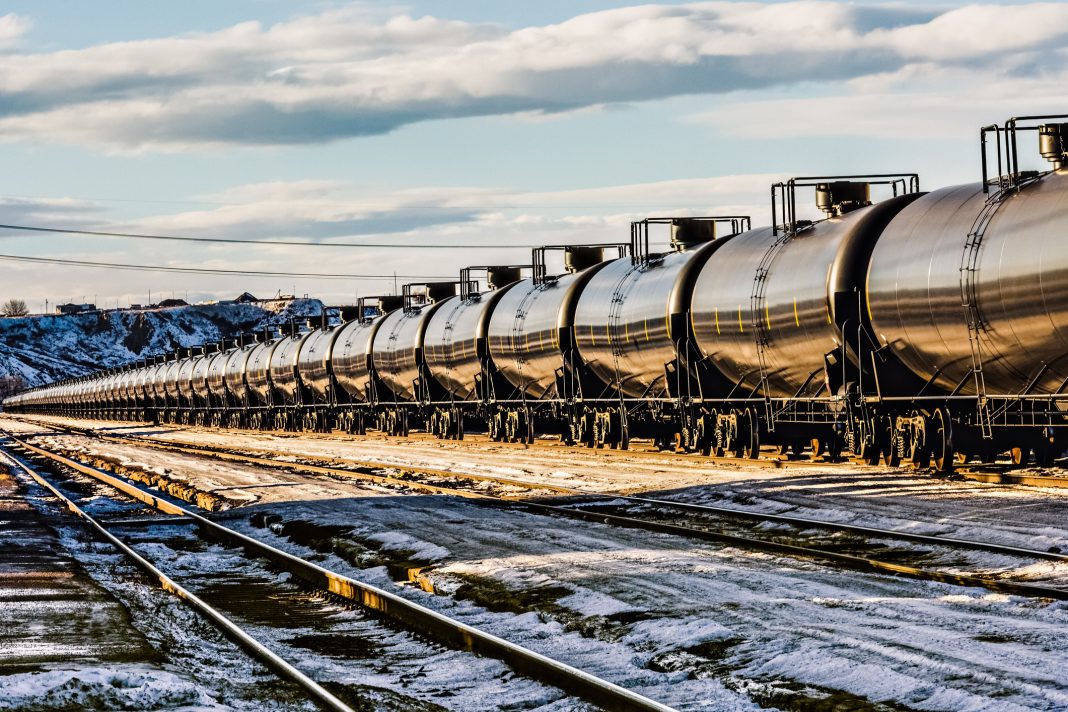The toxic risks of vinyl chloride have been debated for years, but a recent train derailment in the US brought this debate into the public eye, say Jessie R Badley, Caleb Ryce and Pamela J Lein
Three days after the 3 February 2023 derailment of a 50-car freight train in East Palestine, Ohio, emergency crews from Norfolk Southern, the chemical transportation company, made the decision to vent and burn toxic vinyl chloride from five tank cars to prevent an explosion.
A black mushroom plume of toxic gas that could be seen for miles engulfed the town. The subsequent death of more than 43,000 aquatic animals living in the vicinity of East Palestine during the month after the controlled release prompted public concerns about drinking water and air contamination in not only East Palestine but also neighbouring communities since the East Palestine watershed empties into the Ohio River, which is a primary source of water for many municipalities.
The US Environmental Protection Agency (EPA) has informed East Palestine residents that their testing of environmental samples has failed to detect contaminants of concern.
However, independent testing results indicate otherwise and many scientists anticipate that the community of East Palestine will face human health and environmental consequences from this chemical incident for a very long time to come.
What is vinyl chloride?
Vinyl chloride is the synthetic building block of polyvinyl chloride (PVC), a hard resin widely used to make plastic products, wire coatings and pipes. PVC is the world’s third-most-produced synthetic plastic polymer and more than 40 million tons are produced annually.
Beginning in the 1940s, vinyl chloride was also used in cosmetics and household aerosols; however, as health concerns became apparent, regulatory measures were introduced to ban the use of vinyl chloride in these consumer products.
When burned, vinyl chloride monomer breaks down into two toxic gases known as phosgene and hydrogen chloride. Phosgene, an odourless pulmonary irritant, was responsible for nearly 80% of all chemical weapon fatalities in World War I. Hydrogen chlorine is extremely irritating to the skin, eyes and mucosal surfaces because it quickly reacts with the water in these tissues to form hydrochloric acid that can cause serious burns.
Additionally, the manufacture and burning of PVC is known to create dioxins, a highly toxic group of persistent organic pollutants. Dioxins can travel long distances in the air and are readily detected in soil and water, where they can persist for years. Dioxins bioaccumulate up the food chain and it is well-documented that they are carcinogenic and disrupt immune function in humans.
How is vinyl chloride regulated?
The train derailment in East Palestine, Ohio, spurred major criticism of the railroad industry in the United States and led to reconsideration of regulations on how vinyl chloride is produced, transported, stored and disposed of.
In the US, the Toxic Substances Control Act (TSCA) of 1979 authorises the EPA to control hazardous chemicals such as vinyl chloride. In Europe, the Registration, Evaluation, Authorisation & Restriction of Chemicals (REACH) legislation was passed in 2007 to similarly regulate hazardous chemicals.
Although the intent of TSCA and REACH are the same, there are notable differences. For example, REACH requires that chemical companies provide information regarding potential effects on human and environmental health, whereas TSCA does not require such information.
TSCA also places the burden of proof on the EPA to demonstrate that a chemical poses a risk to environmental or human health before it can regulate its production or use.
Conversely, REACH legislates the chemical companies to prove there are no adverse effects of the chemical. In the US, exposure limits for vinyl chloride were set by the Agency for Toxic Substances & Disease Registry (ATSDR), with individual restrictions on the presence of vinyl chloride in our food, water, and air.
Immediate and long-term health effects from exposure
Exposure to vinyl chloride has been associated with diverse adverse health effects. Vinyl chloride is a genotoxic substance, meaning it can cause mutations in DNA and so it is not surprising that cancer, and in particular liver cancer and angiosarcoma, a rare cancer of the blood vessels, are among the primary adverse health effects associated with vinyl chloride.
Inhalation of vinyl chloride can irritate the respiratory system and lead to coughing, chest pain and difficulty breathing. Acute vinyl chloride exposure has been documented to cause nervous system disorders, such as headaches, drowsiness, dizziness and nausea, while chronic exposure can lead to nerve impairment. Low-level exposures to vinyl chloride have also been linked to liver damage.
Transporting hazardous chemicals: Lessons learned
Every year, approximately 3.1 billion tons of hazardous chemicals are transported in the US, and 8.2 million tons of hazardous chemicals are transported in European Union member states. The East Palestine, Ohio, incident stands as a sobering illustration of the toxic risks posed to the local communities through which these chemicals are transported.
The magnitude of this risk is suggested by data collected by the EPA indicating that chemical releases resulting from train derailments, truck crashes, pipeline ruptures or industrial plant leaks and spills happen every day across the US. These data underscore the urgent need for stringent regulations and a proactive approach to managing and monitoring chemical production, transportation, storage and disposal.
Drawing lessons from the East Palestine, Ohio, incident, it is vital for communities and regulatory bodies to collaborate in strengthening preparedness, response capabilities and environmental safeguards to minimise not only the immediate but also long-term impacts of chemical releases.
As global dependence on hazardous chemicals increases, a comprehensive and transparent strategy for regulating the production, transportation, storage and disposal of these chemicals, as well as efforts to develop safer chemical alternatives, are pivotal to safeguarding human health and the environment.

This work is licensed under Creative Commons Attribution-NonCommercial-NoDerivatives 4.0 International.


